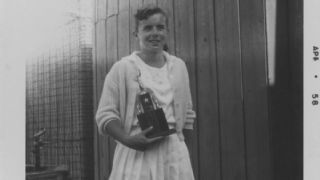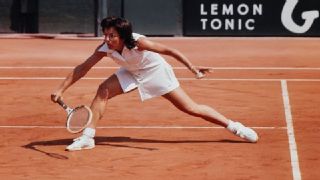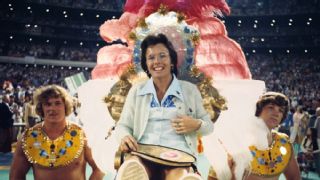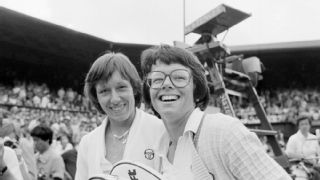|
Champion. Activist. Legend. These words line the walls leading into "Billie Jean King: The Road to 75," a photo exhibition that opened in October at the New-York Historical Society in New York City, marking the icon's 75th birthday this Thursday and her impact upon American society and culture. Many people know King as a tennis pioneer, the woman who defeated former Wimbledon champion Bobby Riggs and his hubris in what became known as the "Battle of the Sexes" on Sept. 20, 1973. Yet tennis was only one part of the equation. "She's more than just a champion," said the New-York Historical Society's Dr. Marilyn Satin Kushner, who co-curated the exhibit alongside researcher Helen R. Russell. "We wanted to use [tennis] as a platform, just as she used it as a platform to go further, to do good for people and have women paid the same as men were paid, to have women become respected as pros, then LGBT rights." The story of King, née Billie Jean Moffitt, is a well-known one. The Long Beach, California, native became a tennis champion, a founder of professional women's tennis, the first sportswoman to win $100,000 in a one-year period, co-founder of the Women's Sport Foundation and an advocate for numerous causes. King has remained in the spotlight fighting for justice on and off the court, and last year's movie "Battle of the Sexes," brought renewed attention to some aspects of her story. But what makes "The Road to 75" fresh is the new perspective of today's environment, where treatment of women and their roles in society are once again under scrutiny. For veteran tennis journalist and historian Steve Flink, who first met King in 1973 while serving as Bud Collins' statistician at Wimbledon, it's an opportunity to better appreciate what King and her colleagues accomplished. "Imagine what it was like in 1970, when they started the women's tour. They were trying to establish themselves as athletes," he said. "Think about the courage, grit and gumption of Billie Jean to try to make an identity for herself. You see what's going on in the world now, the ongoing struggles of the MeToo movement, it makes it even more extraordinary, retrospectively, to see what Billie Jean was able to achieve across her lifetime and what it meant to women's sports." Russell added, "it's an opportunity to see Billie Jean on a different platform." The public is familiar with King through documentaries, feature films and television broadcasts. But the power of a still image on a wall, unmoving and lasting after a few moments, is a new way to tell the champion's story. It's where history can come alive. "It makes you watch living history [differently]," Kushner said. "We are watching history being made every day." "Billie Jean King: The Road to 75," features 75 images and runs through Jan. 27, 2019, at the New-York Historical Society in New York City. The images published below are featured in the exhibit. 
Billie Jean grew up in Long Beach, California, and she was outside every day. Her father, Bill Moffitt, was a tremendous athlete. Her brother Randy pitched for the San Francisco Giants and had a 12-year career in the MLB. And growing up a stone's throw from the Los Angeles Tennis Club, she had access to see the greats of the game. In that era, one of the biggest tournaments [the Pacific Southwest Championships] was held at the LATC. She could witness it, and that goes back to her own quote: "You have to see it, to be it." -- Helen R. Russell  There's a new appreciation for what [Billie Jean] did to help establish the women's tour. It could not have been done without Gladys Heldman, who reached out and got Virginia Slims and Philip Morris to sponsor. But Billie Jean was the most indispensable player that they had. If Billie had not signed that $1 contract along with the eight others, I don't think this would have worked. It took a lot of guts for her to join forces with those other players knowing there was a potential for failure. -- Steve Flink  This is a beautiful action shot of Billie beating Evonne Goolagong [Australian former world No. 1 tennis player] at Roland Garros in '72, which was one of her greatest years. As someone who followed the game closely, I think that was the best tennis Billie ever played on a consistent basis. -- Flink  I don't know how she did what she did in 1973. At Wimbledon, she won all three events, which is rarely done. She won the women's singles, the women's doubles and the mixed doubles. Nobody does that anymore. It's incredible. Billie also founded the Women's Tennis Association (WTA) in '73. Then in September of that year, she beat Bobby Riggs in "Battle of the Sexes." She really made her mark. -- Former United States Tennis Association president and tennis historian Jane Brown Grimes  That's one of the most iconic photographs of BJK. She was 29 years old and Bobby was 55 when they played. They [King and Riggs] were close, and Billie Jean respected him. A few days before he passed away, she called him and he said [something like], "We made a difference, didn't we?" And she said, "Yes, we did, Bobby." -- Russell  She went to Washington, D.C., and spoke at the hearings for Title IX. That was for sport, and that was for women. This was Billie's agenda in the 1970s, and I don't think she was going to let anything distract her from what she set out to do. She wanted to lift women's sport into a better position. -- Brown Grimes  Billie looks like she's enjoying herself here. She always had that sense of self that's there to this day. She doesn't look overwhelmed or daunted -- she looks very comfortable being on the same stage as Muhammad Ali, which I find remarkable, but not surprising. -- Flink  You can learn a lot from a photograph. This was at the National Women's Conference that took place in 1977. The torch Billie Jean is holding was carried from Seneca Falls, New York, which was the birthplace of the women's movement, to Houston. This speaks to the history of the women's movement and who Billie is. -- Dr. Marilyn Satin Kushner  Billie Jean King recognized the need for players to come up behind her. Chris Evert was the first one who broke onto the scene, and Martina [Navratilova] came right after her. Billie was adamant to the older players that they needed to nurture and encourage new players. -- Brown Grimes  This was the other side of Billie Jean. Besides wanting to be a top tennis player, she wanted to fight so that everyone had the same rights. -- Kushner  She loved the fight. She'd rush the net. She wanted to get in there and hit the ball. And that's how she came at life. She wasn't going to hang back on the baseline and wait for the ball to come to her. That's what she's done throughout her life to the very last picture you have in here -- Billie as [one of] the grand marshal[s] of the Pride March. -- Brown Grimes Lindsay Sarah Krasnoff is a historian and author of "The Making of Les Bleus: Sport in France, 1958-2010." Follow her on Twitter (@Lempika7)
|

